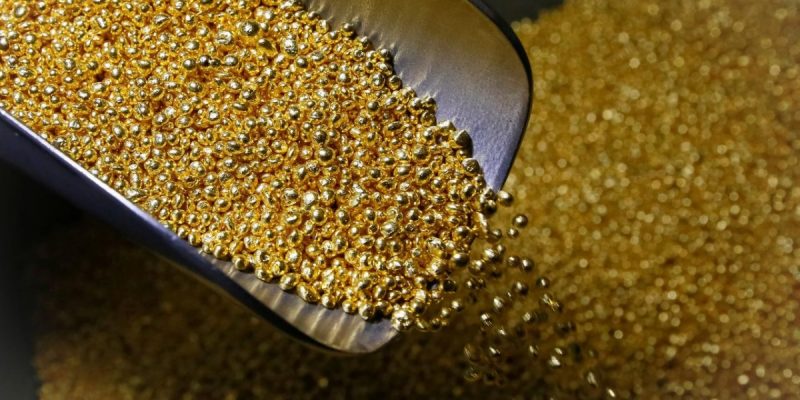Gold price swings as Ukraine crisis sharpens market divide
The crisis over Ukraine pushed gold to a one-year peak last week before a sharp reversal, and the price volatility widened a gulf between bulls and bears of the precious metal that has been growing for months.
In one camp, banks such as Goldman Sachs see gold setting new highs as it becomes the “currency of last resort” in a time of high inflation and global uncertainty. In the other, the likes of UBS, who say rising interest rates across the globe will diminish the luster of an asset that produces no income and offers no claim on any earnings.
The question in the gold market now is whether prices top the $2,000 per ounce they last saw in August 2020.

It did not happen on Thursday, despite a spike in the hours after Russia launched its assault on Ukraine. Benchmark New York gold futures peaked at $1,977 per ounce during a flight to safe-haven assets, up over 2% in less than a day. By the end of the trading week they were down to $1,889, reflecting investors’ perception that sanctions imposed on Russia by the U.S. and others were not going to hit the global economy as hard as first feared. Tougher action from the international community over the weekend suggests more volatility to come.
Gold is still up 6% from a month ago and remains near its highest level since January 2021.
That is against the backdrop of a U.S. dollar that has been strengthening over the past nine months and spiked further during last week’s flight-to-safety trade. A stronger dollar weakens the purchasing power of other currencies.
Japanese yen-denominated gold prices last week hit a record high of 7,166 yen per gram. Indian rupee-denominated gold is around 4,699 rupees per gram, the highest since August 2020.
“Uncertainty over how the current geopolitical situation goes determines gold prices now,” said Masayo Kondo, president of Tokyo’s Commodity Intelligence.
“It is realistic that the prices could soar past $2,000 depending on Ukraine tensions,” said gold market analyst Koichiro Kamei at Tokyo’s Market Strategy Institute.
TD Securities of the U.S. explained that some of the surge in the gold price in the immediate aftermath of the Russian military action was related to wider worries about commodity supplies. “Significant concerns are emerging over supply disruptions from one of the world’s heavyweight commodity producers, considering that Russia holds a powerful position as a producer for palladium, platinum, gold, oil, gas, nickel, wheat, aluminum, coal and even copper,” Rich Kelly, head of global strategy at TD Securities, wrote in a research note.
He was not convinced the rally would last, however.
“Historically, safe-haven flows have only provided a short-lived boost for precious metals demand, which suggests the bulk of the flow-through implications for gold and silver prices will come from the market’s assessment of implications for rates markets.”
Joni Teves, precious metals strategist at UBS Investment Bank, also told CNBC last week that the recent strength in gold prices will be “short-lived,” saying the market is likely to revert to focusing on macro factors such as widely expected U.S. Federal Reserve interest rate hikes.
Morgan Stanley of the U.S. expects the Fed to lift rates six times in 2022 for a total of 150 basis points. UBS sees gold prices dropping to $1,600 per ounce by year-end.
Although the market initially anticipated that conflict in Ukraine would cool central banks’ interest rate hiking ambitions, given the risks to global growth, that view was tempered by the announcement of sanctions that largely avoided energy.
The value of gold is theoretically linked to real interest rates — that is, interest rates minus inflation — since rising income from other assets such as bonds dulls the appeal of a metal that generates no income.
The gold price has typically been inversely correlated to real interest rates, and real rates look set to climb as the Fed and other central banks tighten monetary policy to deal with stronger inflation.

One thing that could keep real interest rates depressed is if inflation outstrips central bank rate hikes.
Shipping disruptions caused by the pandemic, high oil prices due to geopolitical uncertainty, increasing wages caused by labor shortages — all have sent the prices of goods soaring. In the U.S., the consumer price index for January was up 7.5% compared with a year ago, the highest since 1982.
Gold bulls say concerns over inflation could generate investment demand for the metal. Goldman Sachs last month raised its 12-month price forecast to $2,150 in part because investors see gold as an inflation hedge.
But there are signs central banks could be getting inflation under control. A January survey of consumers by the Federal Reserve Bank of New York found that inflation expectations for one year and three years ahead eased to 5.8% and 3.5%, respectively, from 6.0% and 4.0% in December.
“The decrease in the inflation expectations shows consumers see the current inflation abating by the end of this year,” said Itsuo Toshima, a Japan-based financial market analyst for Toshima & Associates. According to the Federal Reserve Bank of St. Louis, the breakeven inflation rate, which measures the financial market’s expectations for long-term price rises, is now at 2.55%, down from 2.76% in November 2021.
“Interest rates are a more sustainable driver” of the gold price than geopolitical factors, said Toshima, predicting it could fall to around $1,700 later this year. “Non-yielding assets such as gold will face a headwind as the Fed terminates its zero-interest policy.”
An open question for gold investors in Asia, however, is whether rising interest rates in the U.S. will put further upward pressure on the U.S. dollar. That could mean that prices remain elevated in Asian currencies, even if the New York benchmark were to tumble.
![]()





